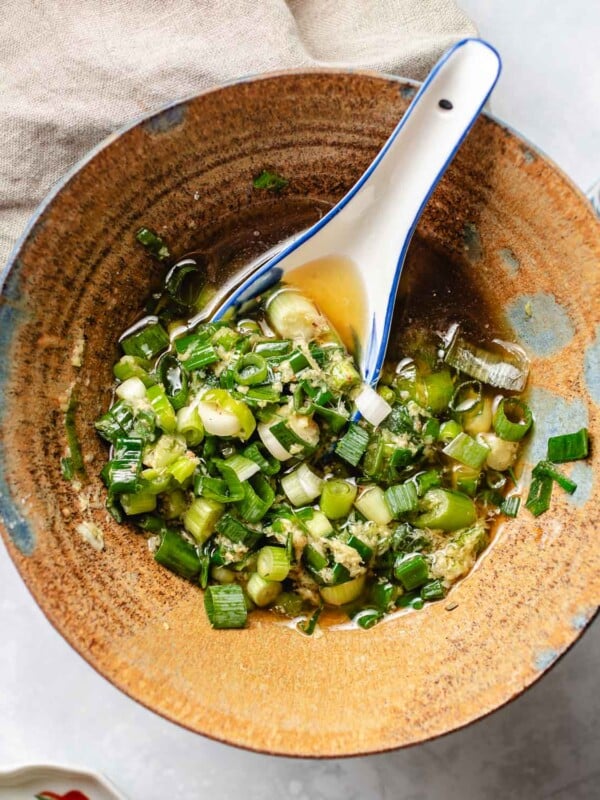This post may contain affiliate links. Please read our disclosure policy.
Shacha sauce, also known as Bullhead bbq sauce, is a super aromatic sauce and is commonly used in Taiwanese cuisine. Sha cha sauce is the Taiwanese take on Malaysian satay sauce with loads of garlic, ginger, shallot, and a seafood flavor.
My homemade version uses the best oil and is easy, healthy, and has no hard-to-find ingredients. The best part? It only takes 20 minutes and you’ll get a good batch that will last you several weeks, plus recipes – Sha cha chicken and Sha cha beef – you can use right away!

Table of Contents
What is Shacha sauce
Also known as sha cha, sacha, it’s a regional Chinese sauce made from dried shrimp, flatfish and various spices. The marriage of aromatic and seafood flavor of the sauce makes it the perfect hotpot dipping sauce and a go-to add-on to your stir fry.

Originally inspired by the Malaysian and Indonesian peanut-based sa te sauce, this Taiwan bbq sauce is a Chaozhou adaptation, which later evolved to become an essential condiment in Fujianese and Taiwanese cuisine.
Although it is often sold as “Chinese BBQ Sauce”, it doesn’t look or taste anything like the typical American-style barbecue sauce.
My recipe is based on the Taiwanese Bullhead barbecue sauce version (source), which is different from the southeast Asia sate sauce that contains peanut butter.
Why homemade?
This homemade sauce recipe is better than other bullhead barbeque sauce recipes as it’s super delicious, umami-forward and a perfect addition to a healthy diet.
- Rich and aromatic: Perfect for stir-fry, soup, Chinese bbq sauce for hotpot, and stew
- Easy to make: Minimal prep and cooking by using ready-made ingredients
- Better oil: My homemade recipe uses avocado oil which is rich in healthy fats, a much better healthy alternative than vegetable or soybean oil. Plus, there is no added sugar.
Ingredients
This rich and tasty sauce is really easy to make and comes in handy for quick stir-fries when you need to whip up a quick dinner after work. The good news is that you can easily find the ingredients for sha cha jiang in your local Asian grocery store.

- Aromatics: Garlic, shallot, ginger
- Dried spices: Coarse salt, toasted white sesame seeds, dried shrimp powder, finely shredded coconut, black pepper, and Korean red pepper flakes (optional)
- Other: Avocado oil, toasted sesame oil, and coconut aminos
Ingredients substitutions
- Use light olive oil: Instead of avocado oil
- Add a pinch of cayenne pepper for a hint of spice: If you can’t find gochugaru (Korean red pepper flakes)
- An extra tablespoon of avocado oil: For those who are intolerant to toasted sesame oil
How to make the sauce
Making this sha cha sauce recipe is quick and easy. Here’s what you need to do to cook this versatile sauce in just 30 minutes:

- On low heat, simmer the garlic in the avocado oil.
- Add shallot and continue to stir occasionally for 5 minutes on low heat.

- Add the ginger, salt, and remaining avocado oil and let them bloom for another 2-3 minutes.
- Add sesame seeds, shrimp powder, and toasted sesame oil. Stir and simmer for 3 minutes.

- Add shredded coconut, black pepper, coconut aminos, and gochugaru. Stir and simmer gently.
- Season with remaining salt and take it off the heat.
Store-bought vs. homemade
Store-bought bull head bbq sauce has no added sugar it is, however, made from soybean oil and is less aromatic. My homemade recipe uses avocado oil, tastes fresh, and is much more fragrant than store-bought.
There’s one specialty ingredient – dried shrimp powder – that’s a must-have in order to make the sauce taste authentic. I purchased mine on Amazon (link in the recipe card below).

Variations
Even though I love the shacha sauce as it is, here are a few tips to level up your sauce game and suit your taste buds.
- Prefer it with an extra spicy flavor? Add chilli powder for an extra kick, especially if you are making the savory sa cha beef.
- Want more nutty? Add a tablespoon of almond or peanut butter, or sesame paste for a closer texture to the Indonesian satay sauce
- For extra umami flavor, add a few teaspoons of shiitake mushroom powder which adds a slightly briny flavor
- Use coconut powder if you can’t find any shredded coconut.
How to store the sauce
Whichever version you decide to go for, the tasty sacha sauce is best stored in an airtight glass container and kept in the fridge.
How long can you keep it? You’d be glad to know that by making the sauce from scratch, it should ideally be used within 2 to 3 weeks of making it. On the other hand, if you decide to grab the store-bought version from your local Chinese grocery store, it can last you a good few months.
How is it used?
There are many great ways to use cha cha sauce in your everyday cooking. Here’s how you can make your dinner even more appetizing:
- A great addition to stir fry dishes like sha cha beef, sha cha shrimp, sha cha chicken, or sha cha pork for a good mix of spicy and sweet flavor
- Add to sha cha soup or Taiwanese chicken rice soup to give it a rich and unique flavor!
- It is the perfect dip to make hot pot sauces, but you can also pair it with Vietnamese pizza for a one-of-a-kind gastronomic experience
- For a mouth-watering barbecue affair, I highly recommend either dipping or using it as one of many meat marinades, such as the crispy grilled chicken drumsticks or lightly layer the sauce on the succulent, savory beef kabobs with broccoli for a delightful combination of flavors.
Common FAQ
The store-bought version contains Soybean oil, garlic, shallots, chilies, Chinese brill fish, and dried shrimp.
A super aromatic, flavorful, and slightly spicy Chinese condiment that can be used for any savory dish.
No. This sauce contains no peanuts.
Substitutions for sha cha sauce
While there isn’t one perfect substitute for sa cha sauce, the closest thing you can get is XO sauce.
If you like your sauce extra spicy, a great alternative is my chili garlic sauce, which is super flavorful, extra garlicky, and has a spicy taste.
Another quick and soy-free option is my homemade hoisin sauce (it’s also paleo-friendly!)

Umami Tips
- The homemade version tastes fresher, fragrant, and with better oil.
- Don’t skip the dried shrimp powder for a better-tasting sauce
- The sauce is much easier to make than you think.
- Use low heat when cooking the sauce to ensure the flavor blooms smoothly.
- All the ingredients you can order online via Amazon.
Shacha Sauce Recipe

Video
Ingredients
- 1 oz garlic cloves finely minced
- 1.8 oz shallot finely chopped, 1 chubby one
- 0.8 oz ginger grated
- 6 tbsp avocado oil divided
- 2 tsp coarse sea salt divided
- 2 tsp toasted white sesame seeds
- 1.5 tbsp dried shrimp powder
- 1 tbsp toasted sesame oil
- 3 tsp finely shredded coconut unsweetened
- ¼ tsp ground black pepper
- 2 tbsp coconut aminos
- ½ tsp gochugaru Korean red pepper flakes, optional
Instructions
- Finely mince the garlic and shallot and grate the ginger. Separate them into 3 separate piles.
- In a heavy-bottom saucepan, start the pan cold with 4 tbsp avocado oil. Add the garlic and simmer over low heat to infuse the oil with garlic flavor. Stir with a wooden spoon until the garlic turns in light golden brown, about 5 minutes.
- Add the shallot. Stir the sauce periodically for another 5 minutes. Make sure the aromatics aren’t burnt. Keep the heat low.
- Add the ginger, 1 tsp salt, and the remaining 2 tbsp avocado oil and continue to gently bloom and infuse the oil over low heat for another 2-3 minutes.
- Add the sesame seeds, shrimp powder, and toasted sesame oil. Continue to stir the sauce and simmer for another 3 minutes.
- Add the shredded coconut, black pepper, coconut aminos, and gochugaru, if using. Stir and bring it to a gentle simmer, about 3 minutes.
- Season with the remaining 1 tsp salt and turn off the heat.
- Once the shacha sauce is cool to room temperature, transfer it into a glass jar to pack and seal. Store the sauce in the fridge. Good for 2-3 weeks.
Notes
- Ingredients substitutions
- Use light olive oil: Instead of avocado oil
- Add a pinch of cayenne pepper for a hint of spice: If you can’t find gochugaru (Korean red pepper flakes)
- An extra tablespoon of avocado oil: For those who are intolerant to toasted sesame oil
- How to use the sauce – Use it as a stir-fry sauce, Add it to soup for extra flavor, Use as a dipping sauce – great for grilled meats and steak, or as a barbeque sauce – great for vegetables, chicken, seafood, beef, pork, and lamb BBQ.
- Try the sauce with my Sha Cha Chicken recipe!
- Add the sauce to hotpot sauces!
Nutrition
Nutrition information is automatically calculated, so should only be used as an approximation.
Made a dish and loved it? Please rate the recipe and leave a comment in the section below! It helps my blog grow organically, allowing me to continue sharing free and awesome content with you. Thank you!













My husband is allergic to shellfish. Is there a substitute for the dried shrimp powder that can be used in the ShaCha sauce or can the dried shrimp powder be omitted?
Hi Sharon, you need the dried shrimp powder to make the sauce taste authentic. There’s a store-bought vegetarian version. Check it out here – https://amzn.to/40ju27h
Is there another seafood substitute for shrimp powder? M husband is allergic to shellfish, but other fish is fine
To make the flavor authentic, unfortunately no. I recommend another delicious sauce – garlic chili sauce (https://iheartumami.com/garlic-chili-sauce/). :))
Hello! I am unfortunately allergic to shrimp but not a vegetarian. Is there another fish product substitute that would work for a substitute? Maybe bonita flakes or fish sauce?
Thanks for your help!
T
Hi Tessa, so to make shacha sauce taste authentic, you’ll need some seafood-y flavor that brings out umami. 🙂 You can try bonita flakes – maybe ground them into powder first? Let me know how that goes!
The taste is pretty darn close to the store version without all the artificial additives. So excited! Substitutes because I used what I had at home: I toasted dried shrimp and then ground it fine in my coffee grinder, and it worked well for the shrimp powder substitute (which also contains garlic powder and salt so you could add but I didn’t). In place of the shredded coconut, I used the same amount of full fat coconut milk. Any hot paste can be used in place of Gochugaru sauce in my opinion. Thank you so much for your time in creating this recipe. You helped to elevate our hot pot Thanksgiving to another level!
Thank you so much, Dana. Super helpful feedback. And Appreciate your detailed notes. 🙂
Is the shredded coconut dried or fresh?
It’s dried